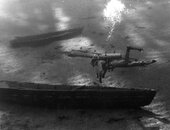I have a 1970s BSAC Diving Manual upstairs. It was a great resource.I'm a bit young for this
I remember reading my dad's BSAC scuba manual when we lived in Singapore in 1968/9. Alas and annoyingly I don't have that manual, but loved reading it as a child (burst lung sounds great!) and always wanted to join him on the scuba trips. I remember it was a wire-bound manual.
My point is that manuals did actually exist in those days, certainly for BSAC, so would really expect other agencies to have written similar. Some people should have those hanging around nowadays.
Would love to find a copy of that manual.
SeaRat





